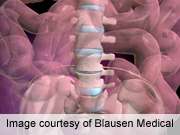Diagnosis of pseudarthrosis after fusion remains difficult

(HealthDay)—There is no definitive method besides surgical exploration to make the diagnosis of pseudarthrosis following spinal fusion surgery, according to a review published in the March 1 issue of The Spine Journal.
Jordan A. Gruskay, from the Yale University School of Medicine in New Haven, Conn., and colleagues reviewed the literature to assess the current status of imaging and clinical practices for assessing pseudarthrosis following spinal fusion.
The researchers found that diagnosing pseudarthrosis following cervical and lumbar fusion remains a challenge. A diagnosis is typically made based on clinical presentation in conjunction with various imaging studies, but no definitive method exists for assessing nonunion. Thin-cut computed tomography scan and computerized motion analysis of dynamic plain films are the best imaging modalities, although surgical exploration remains the gold standard.
"The delineation of fusion versus pseudarthrosis remains challenging," the authors write.
One author disclosed financial ties to the medical device industry.
More information:
Abstract
Full Text (subscription or payment may be required)
Editorial (subscription or payment may be required)
Copyright © 2014 HealthDay. All rights reserved.




















